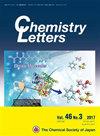Tin Oxides as a Negative Electrode Material for Mg-Ion Batteries
IF 1.1
4区 化学
Q3 CHEMISTRY, MULTIDISCIPLINARY
引用次数: 0
Abstract
SnO as a negative electrode material for Mg-ion batteries exhibited a larger capacity of 540 mA h g−1 at the first cycle than that of pure Sn, despite the lower 88 wt.% Sn content. XRD patterns and XPS spectra revealed the alloying/de-alloying with Sn formed by the reduction during the first charging. The greater capacity is attributed to the shorter Mg diffusion length in the resulting fine Sn particles. MgO matrix played a role in maintaining the high capacity for more than 10 cycles by diminishing the Sn agglomeration.氧化锡作为镁离子电池的负极材料
作为镁离子电池负极材料的氧化锡尽管88 wt.%的锡含量较低,但与纯锡相比,在第一个循环中显示出更大的容量(540 mA h g-1)。XRD 图谱和 XPS 光谱显示,在第一次充电过程中,通过还原形成了与锡的合金化/脱合金化。由于生成的细小锡颗粒中的镁扩散长度更短,因此容量更大。氧化镁基质减少了锡的团聚,从而在 10 个以上的循环中保持了高容量。
本文章由计算机程序翻译,如有差异,请以英文原文为准。
求助全文
约1分钟内获得全文
求助全文
来源期刊

Chemistry Letters
化学-化学综合
CiteScore
3.00
自引率
6.20%
发文量
260
审稿时长
1.2 months
期刊介绍:
Chemistry Letters covers the following topics:
-Organic Chemistry-
Physical Chemistry-
Inorganic Chemistry-
Analytical Chemistry-
Materials Chemistry-
Polymer Chemistry-
Supramolecular Chemistry-
Organometallic Chemistry-
Coordination Chemistry-
Biomolecular Chemistry-
Natural Products and Medicinal Chemistry-
Electrochemistry
 求助内容:
求助内容: 应助结果提醒方式:
应助结果提醒方式:


